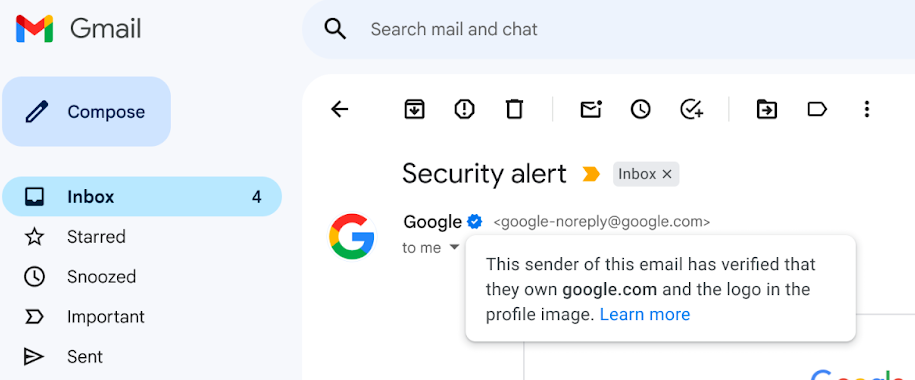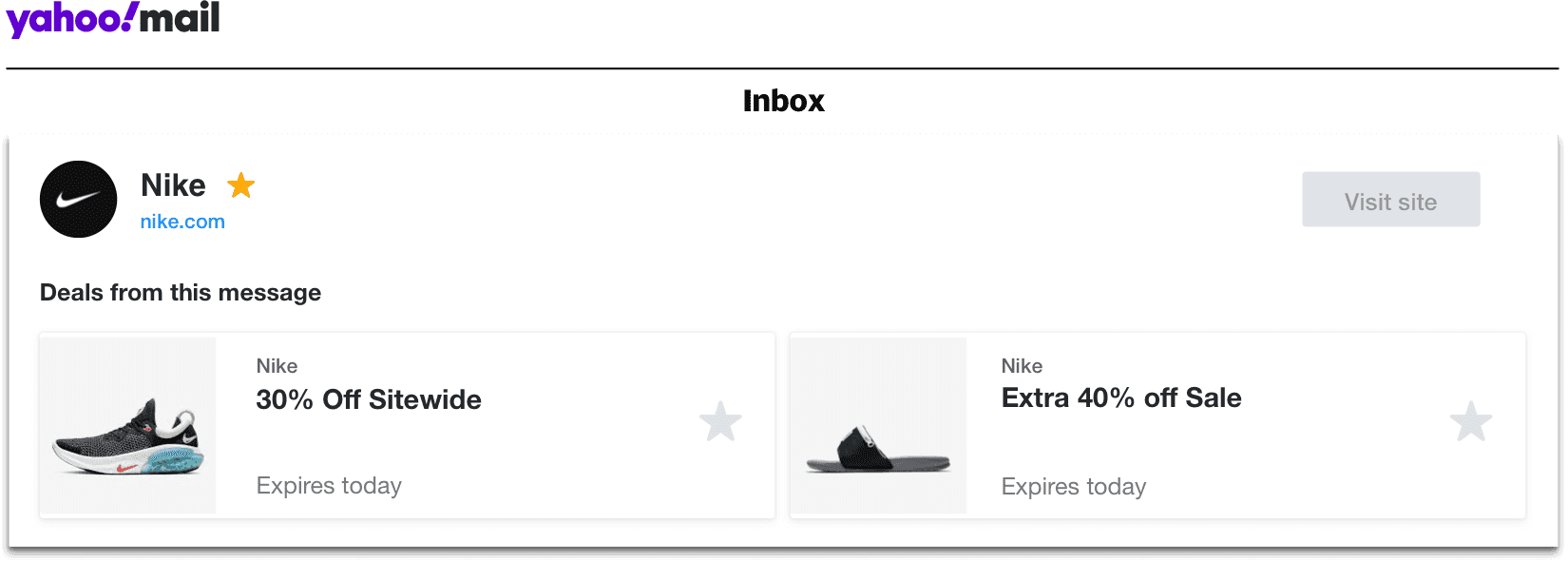Have you ever noticed a brand’s logo next to an email that you received?
That’s BIMI at work – and it’s more than just a fancy image in your inbox.
It stands for Brand Indicators for Message Identification, and it makes emails more trustworthy and easy to spot.
Let’s break down what BIMI is, how it’s changing the email scene, and why you should care about it.
What is BIMI (Brand Indicators for Message Identification)?
BIMI is an authentication method used in email communication. It’s an ID badge placed next to a sender’s name, so the recipients know it’s from the verified company. It works hand-in-hand with DMARC enforcement, a security setup companies use to prevent their email addresses from being faked.

Source: Google Workspace Updates
Who started BIMI? It’s fair to say that the idea of additional authentication started with X (back when it was called Twitter) in June 2009. At that time, a mark verifying authority was rolled out.
Fast forward to 2021, AuthIndicators Working Group (including Google and Mailchimp) and email marketers got together to somehow bring this idea into email inboxes – and created BIMI.
Their mission? Simple – eliminate intrusive fake email messages and make recipients’ inboxes safer with better security protocols.
For example, Yahoo inbox displays BIMI-verified senders with the brand logo next to the company’s name, as here:

Source: Yahoo Sender Hub
Note: The BIMI logo display may differ depending on the recipient’s email service provider.
How does BIMI record work with brand logos?
BIMI works in a pretty logical way.
A domain owner puts a special BIMI DNS TXT record (information about a domain like its IP address, etc.).
When the recipients get emails, inbox providers check that they are from the company they claim to be from. This is the authentication part that works with all email standards.
If the email checks out and is authentic, it automatically looks up that special DNS record.
If there’s a BIMI DNS record for that email, the mailbox providers support BIMI brand indicators for that company.
The result? When the email lands in the recipient’s inbox, it will include the brand-controlled logos with the verified mark certificates next to it.
All it takes is uploading a BIMI file to your email marketing tool setup. This can be a SVG file, or any other file format that works with mail servers. And before you know it, all of your marketing emails are taken more seriously, while you provide better user experience and additional security for your recipients.
Why should you care about BIMI?
Over 75% of targeted cyberattacks start with a single email.
BIMI assists in tackling this problem and helps the recipient to spot fake emails from real ones.
It makes your emails easily identifiable and boosts security and trust in a world where email scams are all too common.
But there are many more reasons why you should seriously think about BIMI adoption.
Lower spam complaints
When you implement BIMI, your brand’s logo appears proudly next to your emails in clients’ inboxes.
It shows them that opening the email does not compromise their safety.
Recipients are less likely to mark your company’s emails as spam (check out why they’re going to spam). It means that BIMI helps you reduce spam complaints and improve open rates.
Better email senders score
Email security is the core of BIMI, not just brand visibility.
When you set up a BIMI TXT record in your email domain’s DNS and follow the latest BIMI requirements, you show mailbox providers you are serious about protecting your brand and their email clients’ safety.
The effort results in a higher sender score.
Higher deliverability
A better sender score translates into higher deliverability.
Email clients and mailbox providers trust your emails more.
They know each message comes from a verified source, thanks to the authentication protocols that BIMI requires.
This trust means your emails are more likely to bypass the spam folder and land right where you want them – in front of your audience and their screens.
Protection against phishing and spoofing
Phishing is the most common form of cybercrime and 8 billion spam emails are sent daily just in the United States.
BIMI is one of the ways to protect your business against these threats.
When you display your brand’s logos in emails, it becomes much harder for scammers to impersonate you.
This type of protection is crucial for both – your brand reputation and the safety of your customers.
When your official brand logo appears next to your emails, it reassures recipients that they’re not dealing with fraudulent emails.
BIMI’s impact on deliverability
BIMI’s impact on email deliverability is more about the ripple effect it creates.
While BIMI itself doesn’t directly boost your emails’ chances of landing in the inbox, it sets off a chain reaction that can.
Brand logo visibility
BIMI setup allows your brand’s logo to appear next to your emails sent.
It’s the factor that increases your brand recognition in the recipient’s inbox.
Visibility is key to brand recognition.
Increased trust
When more recipients engage with your emails, the mailbox provider “takes note.”
They see that your emails are welcomed, not ignored or marked as spam.
This positive engagement is a green light for sending servers. And it signals that your emails are valuable to their users.
This familiarity breeds trust. And in the email world, trust is gold.
Reinforced email authentication
BIMI doesn’t fly solo. It’s a part of a team.
It joins forces with the big names in email security – DMARC, DKIM, and SPF. Together, they’re like the guardians of your email’s credibility.
When you mix these protocols with BIMI, you’re sending fortified and verified emails that land straight into the recipient’s inbox.
Using authentication tools like Bouncer along with BIMI support make a real difference in your deliverability rates.
Here’s how Bouncer and BIMI combination works wonders in email deliverability
Bouncer offers a set of deliverability tools that help your emails get to the right inbox.
- Deliverability testing – Bouncer’s tools let you test how many of your emails actually reach the inbox and how many end up in the spam folder.
- Email setup verification – Bouncer verifies your email server setup, SPF, DKIM, and DMARC – the same standards that BIMI works alongside.
- Blocklist monitoring – Bouncer continuously monitors to verify that your IPs and domains are not listed on any blocklists.
More reasons why? Bouncer provides one of the best coverage on the market. You can get almost 97-99,7% of specified results as soon as you upload the mailing list.
It’s pretty simple math here. The cleaner your mailing is, the better your sender reputation (and deliverability rate)!
👉 Read more:
Mailbox providers that support BIMI email
The list of BIMI supporters is getting longer. The only one currently rejecting the BIMI displayed in their inboxes is Microsoft. There are still many that are considering adopting this authentication method. To check the current status of supporters, go to the BIMI Working Group website.
Which companies are BIMI-ready?
Google Gmail
A front-runner in email services, Gmail is fully on board with BIMI. It displays verified brand logos in users’ inboxes. To get to know more about how to implement a brand logo on Gmail with BIMI, Google Workspace Admin Help provides detailed instructions.
Apple Mail
The first official information about BIMI implementation on Apple appeared in September 2022. For emails to be certified – both the sender and the email provider must adhere to BIMI and Apple Mail standards.
La Poste
France’s La Poste mail service announced BIMI in 2022. The BIMI logos can be seen in La Poste’s list view and message view (as in the example).

Source: BIMI Group
Yahoo!
As an early adopter, Yahoo Mail showcases brand logos and leverages BIMI for better user trust and brand recognition. Yahoo! now displays BIMI logos in the message list and when reading emails Soon, the official logo will appear on their desktop webmail service as well.
Cloudmark
Known for its security focus, Cloudmark has integrated BIMI support and added an extra layer of trust to emails. They’ve got BIMI covered with their BIMI Verify App. It checks each incoming email for DMARC and BIMI-related details.
👉 Read more:
- BriteVerify vs ZeroBounce: The Email List Verification Showdown
- Zerobounce API – The Email Marketer’s Review
Zone
Zone, known for its user-friendly email services, also supports BIMI. It contributes to safer and more recognizable email communication. Zone Webmail requires a verified mark certificate (VMC) to support BIMI.

Source: Zone help
Fastmail
As an added security measure, BIMI logo verification is supported in received and sent emails. To get to know how to implement this service to Fastmail, they provide instructions on their website.
Onet Poczta
A popular Polish email provider, Onet Poczta, has embraced BIMI and now displays brand logos in inboxes like the one below. They encourage their supporting email clients to use BIMI for one more benefit – it is much easier to catch the distinctive sender icon you are looking for among other emails.

Source: Onet Poczta
Verified BIMI mark
BIMI is a trust amplifier.
It turns your email security efforts into tangible deliverability benefits.
It’s an emerging email specification changing the game for domain provider and email clients alike.
Before you implement BIMI, verify that your mailing list standards are high. See Bouncer in action. Get up to 10,000 free validations when you sign up.


